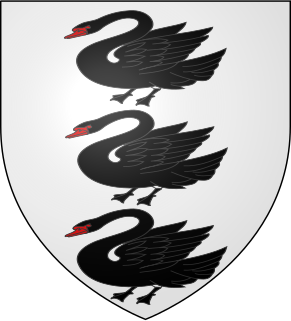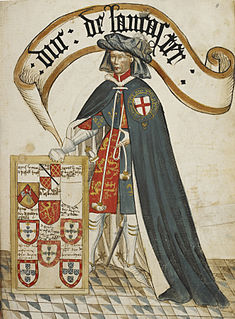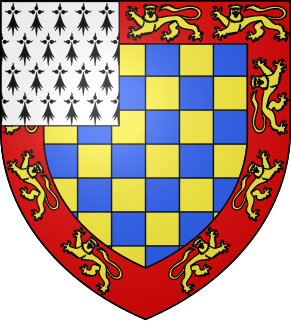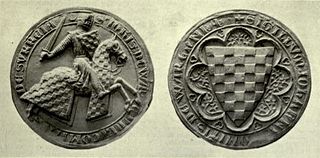 W
WSir Henry de Bohun was an English knight, the grandson of Humphrey de Bohun, 2nd Earl of Hereford. He was killed on the first day of the Battle of Bannockburn by Robert the Bruce. Riding in the vanguard of heavy cavalry, de Bohun caught sight of the Scottish king who was mounted on a small palfrey (ane gay palfray Li till and joly) armed only with a battle-axe. De Bohun lowered his lance and charged, but Bruce stood his ground. At the last moment Bruce manoeuvred his mount nimbly to one side, stood up in his stirrups and hit de Bohun so hard with his axe that he split his helmet and head in two. Despite the great risk the King had taken, he merely expressed regret that he had broken the shaft of his favourite axe.
 W
WSir William Brabazon, K.B. of Sproxton, Leicestershire was an English politician who represented Leicestershire and Northamptonshire in Parliament.
 W
WNicholas Carew was a baron of medieval England who took part in the Wars of Scottish Independence.
 W
WSir Hugh de Cressingham was the treasurer of the English administration in Scotland from 1296 to 1297. He was hated by the Scots and did not seem well liked even by the English. He was an adviser to John de Warenne, 6th Earl of Surrey at the Battle of Stirling Bridge. He suggested a full-scale attack across the bridge, which cost the English the battle and led to his death.
 W
WJohn Botetourt, 1st Baron Botetourt was an English military commander and admiral in the 13th and 14th centuries.
 W
WEdward I, also known as Edward Longshanks and the Hammer of the Scots, was King of England from 1272 to 1307. Before his accession to the throne, he was commonly referred to as The Lord Edward. The first son of Henry III, Edward was involved from an early age in the political intrigues of his father's reign, which included an outright rebellion by the English barons. In 1259 he briefly sided with a baronial reform movement, supporting the Provisions of Oxford. After reconciliation with his father, however, he remained loyal throughout the subsequent armed conflict, known as the Second Barons' War. After the Battle of Lewes, Edward was hostage to the rebellious barons, but escaped after a few months and defeated the baronial leader Simon de Montfort at the Battle of Evesham in 1265. Within two years the rebellion was extinguished and, with England pacified, Edward joined the Ninth Crusade to the Holy Land. He was on his way home in 1272 when he was informed that his father had died. Making a slow return, he reached England in 1274 and was crowned at Westminster Abbey.
 W
WEdward II, also called Edward of Caernarfon, was King of England from 1307 until he was deposed in January 1327. The fourth son of Edward I, Edward became the heir apparent to the throne following the death of his elder brother Alphonso. Beginning in 1300, Edward accompanied his father on campaigns to pacify Scotland. In 1306, he was knighted in a grand ceremony at Westminster Abbey. Following his father's death, Edward succeeded to the throne in 1307. He married Isabella, the daughter of the powerful King Philip IV of France, in 1308, as part of a long-running effort to resolve tensions between the English and French crowns.
 W
WEdward III, also known as Edward of Windsor before his accession, was King of England and Lord of Ireland from January 1327 until his death in 1377. He is noted for his military success and for restoring royal authority after the disastrous and unorthodox reign of his father, Edward II. Edward III transformed the Kingdom of England into one of the most formidable military powers in Europe. His fifty-year reign was the second-longest in medieval English history, and saw vital developments in legislation and government, in particular the evolution of the English Parliament, as well as the ravages of the Black Death. He outlived his eldest son, Edward the Black Prince, and the throne passed to his grandson, Richard II.
 W
WSir William FitzWarin was an English soldier active during the First War of Scottish Independence. He was the constable of Urquhart Castle (1296-1297) and after the English defeat at the Battle of Stirling Bridge on 11 September 1297, he was appointed constable of Stirling Castle, which he later surrendered and was imprisoned in Dumbarton Castle.
 W
WDavid Flitwick, of Flitwick, Bedfordshire, was an English politician and soldier of the Anglo-Scots Wars.
 W
WDavid Flitwick (1281–1353), of Flitwick, Bedfordshire, was an English politician and soldier of the Anglo-Scots Wars who followed in the footsteps of his grandfather, also David Flitwick.
 W
WSir Thomas Grey of Heaton Castle in the parish of Cornhill-on-Tweed, Northumberland, was a soldier who served throughout the Wars of Scottish Independence. His experiences were recorded by his son Thomas Grey in his chronicles, and provide a rare picture of the day to day realities of the Wars. His career, blemished by his suicidal charge at the Battle of Bannockburn, a contributing factor to the devastating English defeat, is perhaps best known for his role in the tale of Sir William Marmion the chivalric knight of Norham Castle.
 W
WHenry of Grosmont, 1st Duke of Lancaster was an English statesman, diplomat, soldier, and Christian writer. The owner of Bolingbroke Castle in Lincolnshire, Grosmont was a member of the House of Plantagenet, which was ruling over England at that time. He was the wealthiest and most powerful peer of the realm.
 W
WWalter de Huntercombe, 1st Baron Huntercombe (1247–1313) was an English military commander during the Wars of Scottish Independence and a Governor of Edinburgh Castle.
 W
WRoger Northburgh was a cleric, administrator and politician who was Bishop of Coventry and Lichfield from 1321 until his death. His was a stormy career as he was inevitably involved in many of the conflicts of his time: military, dynastic and ecclesiastical.
 W
WWilliam de Ormesby was a 13th-14th century English judge. He was the Justice of Scotland between 1296 and 1297 after the invasion of Scotland by England in 1296.
 W
WAymer de Valence, 2nd Earl of Pembroke was a Franco-Welsh nobleman. Though primarily active in England, he also had strong connections with the French royal house. One of the wealthiest and most powerful men of his age, he was a central player in the conflicts between Edward II of England and his nobility, particularly Thomas, 2nd Earl of Lancaster. Pembroke was one of the Lords Ordainers appointed to restrict the power of Edward II and his favourite Piers Gaveston. His position changed with the great insult he suffered when Gaveston, as a prisoner in his custody whom he had sworn to protect, was removed and beheaded on the instigation of Lancaster. This led Pembroke into close and lifelong cooperation with the King. Later in life, however, political circumstances combined with financial difficulties would cause him problems, driving him away from the centre of power.
 W
WHenry de Percy, 1st Baron Percy of Alnwick was a medieval English magnate.
 W
WJohn of Brittany, 4th Earl of Richmond, was an English nobleman and a member of the Ducal house of Brittany, the House of Dreux. He entered royal service in England under his uncle Edward I, and also served Edward II. On 15 October 1306 he received his father's title of Earl of Richmond. He was named Guardian of Scotland in the midst of England's conflicts with Scotland and in 1311 Lord Ordainer during the baronial rebellion against Edward II.
 W
WJohn de Warenne, 6th Earl of Surrey was a prominent English nobleman and military commander during the reigns of Henry III of England and Edward I of England. During the Second Barons' War he switched sides twice, ending up in support of the king, for whose capture he was present at Lewes in 1264. Warenne was later appointed a Guardian of Scotland and featured prominently in Edward I's wars in Scotland.
 W
WRichard Talbot, 2nd Baron Talbot was an English nobleman and soldier. As the husband of the heiress Elizabeth de Comyn, he played a role in the Second War of Scottish Independence.
 W
WGilbert de Umfraville, Earl of Angus was the first of the Anglo-French de Umfraville line to rule the Earldom of Angus in his own right.
 W
WWilliam de la Zouche (1299–1352) was Lord Treasurer of England and served as Archbishop of York from 1342 until his death.
 W
WWilliam la Zouche, 1st Baron Zouche (1276/86–1352) lord of the manor of Harringworth in Northamptonshire, was an English baron and soldier who fought in the Wars of Scottish Independence. He is referred to in history as "of Harringworth" to distinguish him from his first cousin Alan la Zouche, 1st Baron la Zouche (1267–1314) of Ashby de la Zouch in Leicestershire.